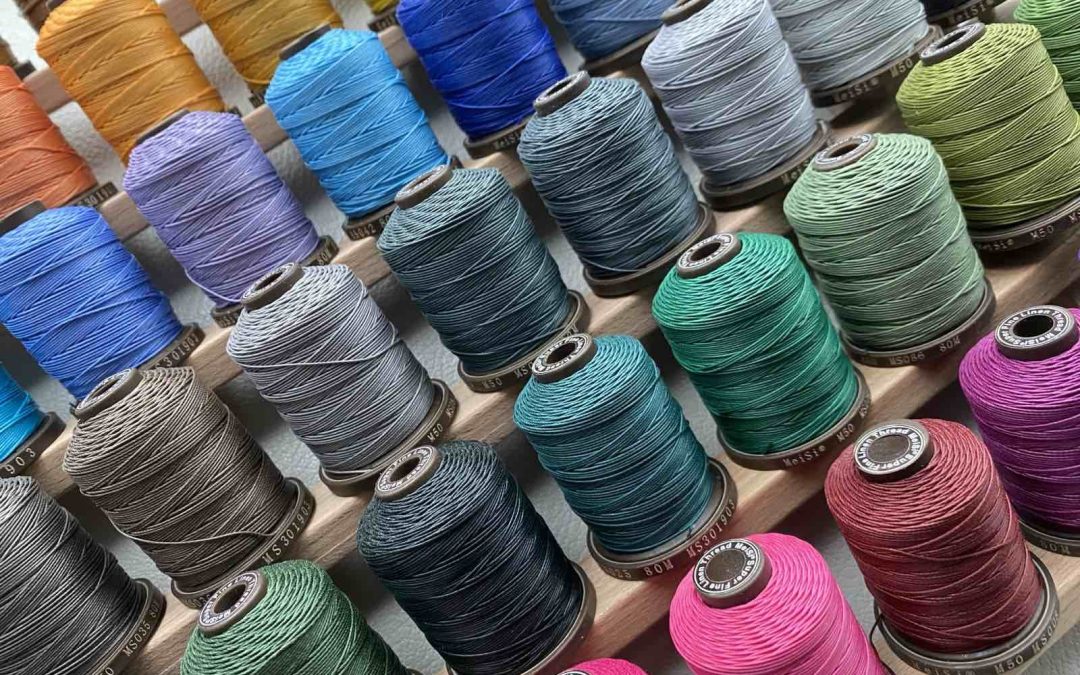When I started my journey as a leather craftsman in 2008, there was very little information about the craft, modern materials and how to work with them. It was a time when knowledge was a competitive advantage: information was scarce and those who had it were not particularly willing to share it. I had to gather information bit by bit, spending a lot of time and money researching and testing materials to improve my skills, products and workflow.
While I could still find leather and a basic set of tools to get started, thread was much more difficult. I quickly realized that machine sewing leather threads are not suitable for hand saddle stitching because:
- have a low twist density (number of turns per unit length)
- untwist during sewing
- Loops forming knots and tangles
- have no wax and do not lend themselves well to hand waxing
- frizz
- lose their appearance and structure
- have a relatively high elasticity
When sewing by hand with this thread, it is difficult to control the tension and beauty of the stitches. Such threads are unable to hold a tight “knot”.
Synthetic “flat” braided waxed threads were also available for hand sewing. Usually these were threads of Asian and Turkish production (no name). It was less common to find threads made in Italy. Many masters started working with such threads. Sew them much easier, but still had a number of limitations: a small range of colors and often poor quality. The problem was also in the limited choice of thicknesses of 0,8-1,7 mm. Such a thread in a stitch that stitch close to 5 mm look very rough and archaic. Create a delicate and elegant product with a thread of this thickness is almost impossible.
Years went by and during this time in my search I managed to find and work with threads from Asian nettle Rami (analog of linen thread). Even tried bought at international auctions antique, vintage linen thread for hand sewing from companies that did not survive the competition with synthetic fiber and the technological revolution Willimantic Linen Company’s, Barbour`s, Campbell ….
The development of the Internet and openness gave me the opportunity to closely observe famous craftsmen and manufacturers around the world and find out what threads they use in their work and production. So I found and tried the products of sellers of various threads, many of them were not manufacturers, but only represented the product under their name (brand). This limited me as a customer.
There was a moment when it seemed to me that I had already found what I was looking for. It was synthetic threads:
RITZA by JULIUS KOCH (Germany) and linen threads from SAJOU Fil Au Chinois (France) that I used in my work. Over time I realized that brand awareness and the stability of “quality” were not enough, although at the beginning of my journey it seemed to be a decisive factor. With the development of technology, quality standards are constantly rising, as are the requirements for the manufacturers and the product itself (threads):
- expanding the range of articles and color palette
- possibility to receive consultation and information support
- improving the quality of their products
- Improved packing and packaging
- convenience of purchase and prompt delivery
After 9 years, in 2017, my search led me to Ming Lang, a company that not only meets all modern requirements, but is constantly improving. I finally found the threads that meet my requirements and are perfect for my tasks. That was the moment when I felt that all the effort and searching was not in vain. I remember the first time I picked up their threads and enjoyed the process of sewing. It felt as if all my previous difficulties were just steps towards this discovery. With each stitch, I realized that this was exactly what I had been looking for all these years.
In the last couple of years, Ming Lang has increased the number of color palettes by 2-3 times. For example Meisi linen had about 40 colors and now it has over 100. The company has developed, patented and introduced spools with a convenient clip for the tip of the thread, as well as spools with different lengths of winding and special reels for sewing machines. Started production of revolutionary new articles of thread: MeiSi Super Fine, WeiXin, XianGe twist, … Throughout the period provides information support, catalogs of its products and samples for promo, samples, tests … Working to expand the number of its representatives and distributors around the world. It has become much more convenient and cheaper for me to purchase quickly from my local MeiSi Europe representative.
Finding the perfect threads for my work has become not just a solution to a pressing problem, but a step towards improving my craftsmanship. Since I started working with Ming Lang products, each piece has taken on a new level. Satisfied with the results, I know I’ve found a partner I can rely on – and that’s how my craft continues to grow and evolve.
Kondratenko, V. (2024g, October 4). My Search for the Perfect Threads for Leatherwork: A Personal Experience. V.Kondratenko. https://kondratenko.studio/blog/my-search-for-the-perfect-threads-for-leatherwork-a-personal-experience/

